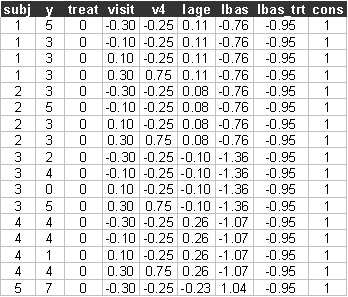Exercise L8, Poisson
model
Thall and Vail (1990), Breslow and Clayton (1993) analysed longitudinal data on the number of epileptic seizures in successive intervals. The data were collected as part of a randomized controlled trial for the treatment of epilepsy which compared the treatment Progabide with a placebo. The data we use here was used by Rabe-Hesketh and Skrondal (2005, exercise 6.1). The data set (epilep.dat) have been stacked ready for analysis.
Data description
Number of observations (rows) 236
Number of variables (columns): 9
Variable description:
subj = Patient identifier
y = number of epileptic seizures over a two week period
treat = 1 if Progabide, 0 placebo
visit = visit time , coded as -0.3, -0.1, 0.1, 0.3
v4 = 1 if the reponse relates to the 4th visit , 0 otherwise (centered about its mean)
lage = logarithm of the patients age (centered about its mean)
lbas = logarithm of ¼ of the number of seizures in the 8 weeks preceding the trial, (centred about its mean)
lbas_trt =interaction between lbas and treat (centered about its mean)
constant = 1 for all observations
The first few lines of epilep.dat look like:

Start Sabre and specify transcript file:
out epilep.log
data subj
y treat visit v4 lage lbas lbas_trt constant
read epilep.dat
Suggested exercise:
(1) Estimate a Poisson model for the response number of epileptic seizures (y) with a constant but without any random effects.
(2) Re-estimate model (1) allowing for the patient effect (subj) random effects. Are the patient random effects significant? How many quadrature points should we use to estimate this model?
(3) Re-estimate model (2) allowing for lbas, treat, lbas_trt lage visit . How does the magnitude of the patient random effect change? Are any of these explanatory variables significant in this model? Do the results make intuitive sense?
(4) re-estimate model (3) adding v4, in place of visit, which model would you prefer?
(5) Interpret your results. Can your preferred model be simplified?
(6) Are there any interaction effects you would like to try in this model? Why?
References
Breslow, N.E. & Clayton, D.G.,
(1993), Approximate inference in generalized linear
mixed models, J. Am. Statist. Ass.,
88, 9-25.
Thall, P. F. & Vail, S. C.,
(1990), Some covariance models for longitudinal count
data with overdispersion, Biometrics, 46, 657-671.